FT的第二语言习得价值分析
浅析第二语言语用习得研究对外语教学的启示

浅析第二语言语用习得研究对外语教学的启示第二语言语用习得是指学习者在第二语言学习过程中,逐渐掌握和运用该语言的语用知识和语用策略的过程。
与第一语言相比,第二语言语用习得的过程更为复杂,因为学习者不仅需要掌握语言的形式和结构,还要理解和运用不同语境下的语用规则和约定。
因此,研究第二语言语用习得对外语教学具有重要的启示。
首先,研究第二语言语用习得可以帮助教师了解学习者在语用意识和策略上的困难。
语用习得常涉及到言语行为、语境、言外之意等方面的知识,而这些知识对于学习者来说可能是陌生的。
通过研究语用习得,教师能够了解学习者在言语行为、礼貌用语、语体、语境等方面的困惑和困难,从而针对性地进行教学和辅导。
比如,教师可以帮助学习者提高言语行为的意识,让他们能够在不同情境下正确运用不同的言语行为策略。
其次,研究第二语言语用习得可以帮助教师设计合适的教学活动和任务。
语用习得是一个实践性的过程,学习者需要在真实的语境中不断实践和运用语用知识。
因此,教师可以设计各种真实的交际情境,让学习者在语用习得的过程中获得更多的实践机会。
比如,教师可以组织学习者进行角色扮演活动,让他们在模拟的情境中运用语言,并及时给予反馈和指导,帮助他们逐步提高语用能力。
此外,研究第二语言语用习得可以帮助教师培养学习者的跨文化交际能力。
语用习得涉及到言语行为在不同文化和社会背景中的差异,学习者需要了解并适应不同的文化和社会规范。
通过研究第二语言语用习得,教师可以帮助学习者了解和尊重不同文化和语言背景下的语用约定,培养学习者的跨文化交际能力。
比如,教师可以引导学习者探讨不同文化中言语行为的差异,让他们具备意识到并避免产生误解和冲突的能力。
最后,研究第二语言语用习得可以促进教师自身的专业发展。
语用习得是一个复杂而庞大的研究领域,对于教师而言,研究语用习得可以帮助他们深入了解第二语言教学的本质和目标,并更好地指导自己的教学实践。
通过参与相关的研究项目或活动,教师可以与其他研究者进行学术交流和合作,提升自己的研究水平和专业素养。
英语教学中的第二语言习得策略

英语教学中的第二语言习得策略在当今全球化的时代,英语作为一门国际通用语言,其重要性日益凸显。
对于许多学习者来说,掌握英语不仅仅是为了满足学业要求,更是为了能够在国际交流、职业发展等方面具备更强的竞争力。
在英语教学中,了解和运用第二语言习得策略对于提高教学效果和学习者的语言能力至关重要。
一、第二语言习得的基本理论第二语言习得是一个复杂的过程,受到多种因素的影响。
其中,克拉申的输入假说和情感过滤假说具有重要的指导意义。
输入假说认为,学习者需要接触大量的可理解性输入,即略高于其现有水平的语言材料,才能有效地习得语言。
这意味着教师在教学中应当提供丰富、多样且难易程度适中的语言输入,例如真实的英语文本、音频和视频材料等。
情感过滤假说则强调学习者的情感因素对语言习得的影响。
焦虑、缺乏自信等负面情感会像过滤器一样阻碍语言输入,而积极的情感状态则有助于学习者更好地吸收语言知识。
因此,营造一个轻松、支持性的学习环境对于促进第二语言习得至关重要。
二、英语教学中的第二语言习得策略1、创造真实的语言环境语言是在特定的环境中使用和习得的。
为了让学习者更好地掌握英语,教师应当努力创造一个真实的语言环境。
这可以通过课堂活动、角色扮演、小组讨论等方式实现。
例如,在教授购物的相关话题时,可以模拟超市的场景,让学生进行实际的购物对话。
此外,利用多媒体资源,如英语电影、歌曲、纪录片等,也能让学生接触到真实的语言使用情境。
2、强调语言输入的质量和数量优质的语言输入是第二语言习得的基础。
教师应选择地道、生动、与时俱进的教材和学习材料,确保学生接触到准确、自然的英语表达方式。
同时,增加语言输入的数量,鼓励学生广泛阅读英语书籍、报纸、杂志,收听英语广播,观看英语电视节目等。
但要注意,输入的内容应与学生的语言水平相适应,避免过于复杂或难以理解的材料。
3、培养学习者的语言输出能力语言输出不仅能够检验学习者对语言知识的掌握程度,还能促进语言的内化和习得。
第二语言习得理论和分析方法

• “自然习得顺序”是指儿童在习得母语规 则和语言项目时遵循一种相似的习得顺 序。
克拉申的输入假说
• 习得与学习假说(acquisition and learning hypothesis)
• 自然习得顺序假说(natural acquisition order hypothesis)
• 监控假说(monitor hypothesis) • 输入假说(input hypothesis) • 情感过滤假说(affective filter hypothesis)
• 4.习得的方法主要靠在自然语言环境中的语 言交际活动,没有大纲和教材;学习是在 教师指导下通过模仿和练习来理解掌握语 言规则。
• 5.习得需要大量的时间,习得效果一般都较 好;学习花费时间一般较少,但学习效果 通常不佳。
• 习得是潜意识的自然的获得;学习是有意 识的规则的掌握。
4、“第二语言习得”与“外语习得”
3. 学习者的个体差异问题
• 这方面的研究主要集中在学习者第二语言 习得的个体差异问题上。
• 比如学习者在语言习得过程中表现出的学 习速率的差异、学习方式的差异、学习风 格的差异以及学习成果的差异等。
• 这方面研究是关于第二语言学习者自身的 研究。
(完整版)国外著名第二语言习得理论综述

国外著名第二语言习得理论综述.人类在普通语言学、心理语言学及认知心理语言学领域认识的深入。
自改革开放以来,特别是近20年来,中国对英语习得的研究取得了很大进展,我国心理语言学家、认知心理语言学家(桂诗春、王初明等)在这一领域做出了极其重要的贡献。
但就第二语言习得理论进行综述及较为详细介绍的文章还不多见。
本文旨在通过对国外三家极有影响的第二语言理论进行较为详细的介绍,使我们对国外同行在这一领域所取得的成就有进一步的了解,有助于我国第二语言习得的研究。
1克拉申的“监察模式”(Monitor model)克拉申的“监察模式”在第二语言习得理论中占有重要地位,曾引起外语教育界广泛关注和讨论。
该理论由S.克拉申在70年代后期发表的一系列论文中(Krashen1977a,1977b,1978a,1978b)论述,并在他撰写的几本专著中得到充实和发展(Krashen1981,1982,1985)。
在“监察模式”理论中,克拉申提出著名的五个假设:习得—学习假设,监察假设,自然顺序假设,输入假设及情感过滤假设。
1.1习得———学习假设(Acguisition-learning hypothesis)克拉申认为,成人第二语言习得者用两种不同的方式获得语言能力。
一是习得,即一种“与小孩习得母语过程相同的下意识过程”(1985,1);二是学习,即“一种有意识的学习语言的过程”(1985,1)。
“习得”来源于自然交际环境中有意义的交流。
谈话者注重的是表达意思,而非语法规则正确与否,对语言表达中的一些错误并不有意识纠正。
与此相反,在语言学习中,发现错误并纠正错误是学习过程的重要环节。
克拉申认为区分语言习得与语言学习的尺码是学习者对语言规则运用的有意识程度,而不是语言环境。
例如,在自然语言环境中,学习可以通过向熟人或朋友询问语法规则来获取语言知识。
同样,在非自然语言环境的教室里,当学生注意力集中在对话、角色扮演、小组讨论等交际活动中时,语言便被习得。
第二语言习得研究

第二语言习得研究第一章第二语言习得研究概述第二语言习得研究作为一个独立的研究领域至今已有40年的历史。
成熟的标志:1.第二语言习得研究的领域不断扩大2.第二语言习得研究涉及的领域越来越宽3.第二语言习得研究从最初的理论假设发展成为一系列的理论模式。
总之, 已经成为一门相对独立的学科。
第一节第二语言习得研究的基本概念一、母语和目的语母语: 通常指学习者所属种族、社团使用的语言, 因而也称作“本族语”。
也称作“第一语言”。
目的语: 也称目的语, 一般指学习者正在学习的语言。
对于第二语言学习者而言, 母语对其目的语的习得具有重要的影响。
二、第一语言和第二语言第一语言: 指儿童由您最先接触和习得的第一语言。
第二语言: 是相对于学习者习得的第一语言之外的任何一种其他语言而言的。
第二语言的概念强调的是语言习得的先后顺序, 与语言习得的环境无关。
三、习得与学习这一对概念用来区分, 两种不同的语言获得的过程和方式。
习得: 类似于儿童母语的获得方式。
学习:指“正式”的语言规则学习, 及通过课堂教学的方式来获得第二语言。
四、第二语言习得与外语习得依据学习者语言习得环境来区分。
第二语言习得是指学习者在目的语国家学习目的语。
学习者所学目的语在该国家是工人的交际工具。
外语习得, 在课堂之外不作为交际工具。
五、自然的第二语言习得与有指导的第二语言习得语言获得方式和环境。
自然的第二语言习得是指以交际的方式获得第二语言。
有指导的第二语言习得是以教学指导的方式获得第二语言, 语言习得通常是在课堂教学环境中发生的。
六、语言能力与语言表达语言能力是由交际双方内在语法规则的心理表征构成的。
语言表达指的是交际双方在语言的理解与生成过程中对其内在语法的运用。
例: 你过来了吗?你说对的。
第二节第二语言习得研究的学科性质一、第二语言习得研究与语言学1.第二语言习得研究从诞生那天起, 就与语言学有一种天然的联系。
2.区别: 一方面, 就研究对象而言, 母语者的语言系统;学习者的语言系统另一方面, 研究目的不同,第三, 语言学家和第二语言习得研究者在分析和解释学习者语言系统的方法上也有所不同。
探析第二语言习得理论对我国大学英语双语教学的影响和启示

探析第二语言习得理论对我国大学英语双语教学的影响和启示【摘要】本文通过对第二语言习得理论和我国大学英语双语教学现状的探讨,分析了第二语言习得理论对双语教学的影响,并提出了关于重视输入与输出以及创设真实语言环境的启示。
在双语教学的发展方向上,本文认为应该注重教学方法的创新和真实语言环境的营造。
第二语言习得理论为我国大学英语双语教学提供了理论支持和指导,并对双语教学的发展方向提供了有益启示。
未来的研究和实践应该更加注重学生的实际语言运用能力的提升,促进双语教学的深入发展。
【关键词】第二语言习得理论、双语教学、大学英语、影响、启示、输入与输出、真实语言环境、发展方向、总结、展望1. 引言1.1 研究背景英语是世界上最为广泛使用的第二语言,对于我国学生而言,学习英语已经成为必修课程。
随着我国与世界各国的交流日益频繁,学生们对英语的需求也越来越迫切。
在传统的英语教学模式下,学生往往只是被动接受知识,缺乏实际运用英语的机会。
这种教学模式不仅难以激发学生学习英语的兴趣,更严重影响了他们的语言习得效果。
1.2 研究目的研究目的是探讨第二语言习得理论对我国大学英语双语教学的影响和启示,从而为双语教学的改进提供理论依据和实践指导。
具体目的包括:分析第二语言习得理论的核心概念和原理,以深入理解语言习得的本质及规律;调查我国大学英语双语教学的现状,了解存在的问题和挑战;探讨第二语言习得理论对双语教学的实际影响,从理论到实践的角度审视双语教学的有效性和改进空间;总结出重视输入与输出、创设真实语言环境等启示,为提升我国大学英语双语教学质量提供参考和建议。
通过本研究,旨在促进双语教学的发展,探索更符合语言习得规律的教学模式,为学生提供更优质的语言学习环境和更有效的学习方法。
2. 正文2.1 第二语言习得理论概述第二语言习得理论是指关于第二语言(或外语)学习和习得的理论体系。
最具代表性的是斯特拉维斯基的认知发展理论、克鲁斯的交流策略理论、斯蒂文斯的认知外语学习理论等。
第二语言习得理论评介
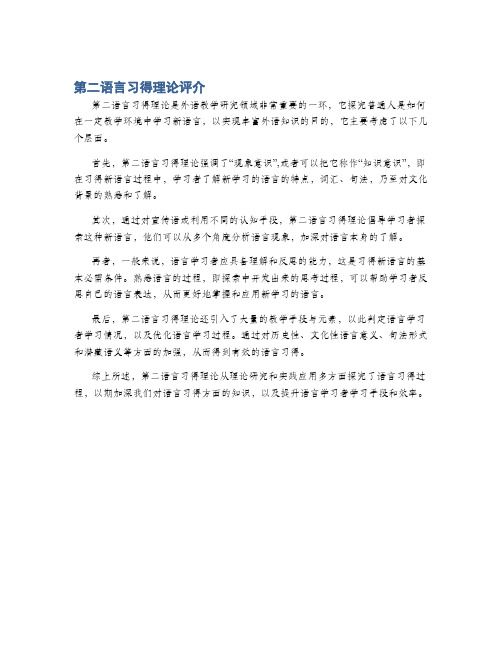
第二语言习得理论评介
第二语言习得理论是外语教学研究领域非常重要的一环,它探究普通人是如何在一定教学环境中学习新语言,以实现丰富外语知识的目的,它主要考虑了以下几个层面。
首先,第二语言习得理论强调了“现象意识”,或者可以把它称作“知识意识”,即在习得新语言过程中,学习者了解新学习的语言的特点,词汇、句法,乃至对文化背景的熟悉和了解。
其次,通过对宣传语或利用不同的认知手段,第二语言习得理论倡导学习者探索这种新语言,他们可以从多个角度分析语言现象,加深对语言本身的了解。
再者,一般来说,语言学习者应具备理解和反思的能力,这是习得新语言的基本必需条件。
熟悉语言的过程,即探索中开发出来的思考过程,可以帮助学习者反思自己的语言表达,从而更好地掌握和应用新学习的语言。
最后,第二语言习得理论还引入了大量的教学手段与元素,以此判定语言学习者学习情况,以及优化语言学习过程。
通过对历史性、文化性语言意义、句法形式和潜藏语义等方面的加强,从而得到有效的语言习得。
综上所述,第二语言习得理论从理论研究和实践应用多方面探究了语言习得过程,以期加深我们对语言习得方面的知识,以及提升语言学习者学习手段和效率。
第二语言习得理论对英语教师的启示
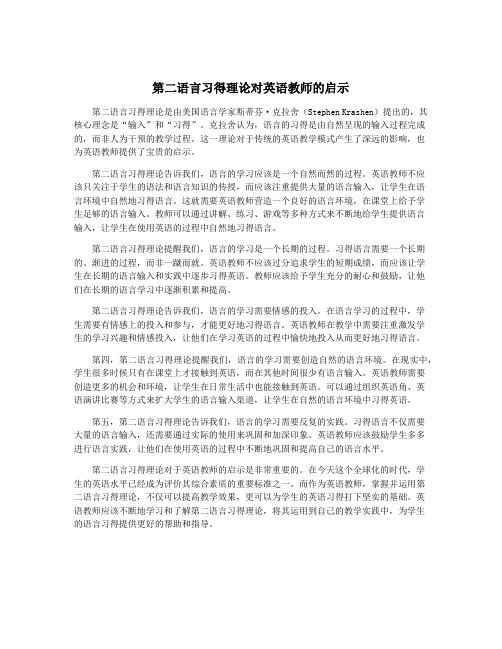
第二语言习得理论对英语教师的启示第二语言习得理论是由美国语言学家斯蒂芬·克拉舍(Stephen Krashen)提出的,其核心理念是“输入”和“习得”。
克拉舍认为,语言的习得是由自然呈现的输入过程完成的,而非人为干预的教学过程。
这一理论对于传统的英语教学模式产生了深远的影响,也为英语教师提供了宝贵的启示。
第二语言习得理论告诉我们,语言的学习应该是一个自然而然的过程。
英语教师不应该只关注于学生的语法和语言知识的传授,而应该注重提供大量的语言输入,让学生在语言环境中自然地习得语言。
这就需要英语教师营造一个良好的语言环境,在课堂上给予学生足够的语言输入。
教师可以通过讲解、练习、游戏等多种方式来不断地给学生提供语言输入,让学生在使用英语的过程中自然地习得语言。
第二语言习得理论提醒我们,语言的学习是一个长期的过程。
习得语言需要一个长期的、渐进的过程,而非一蹴而就。
英语教师不应该过分追求学生的短期成绩,而应该让学生在长期的语言输入和实践中逐步习得英语。
教师应该给予学生充分的耐心和鼓励,让他们在长期的语言学习中逐渐积累和提高。
第二语言习得理论告诉我们,语言的学习需要情感的投入。
在语言学习的过程中,学生需要有情感上的投入和参与,才能更好地习得语言。
英语教师在教学中需要注重激发学生的学习兴趣和情感投入,让他们在学习英语的过程中愉快地投入从而更好地习得语言。
第四,第二语言习得理论提醒我们,语言的学习需要创造自然的语言环境。
在现实中,学生很多时候只有在课堂上才接触到英语,而在其他时间很少有语言输入。
英语教师需要创造更多的机会和环境,让学生在日常生活中也能接触到英语。
可以通过组织英语角、英语演讲比赛等方式来扩大学生的语言输入渠道,让学生在自然的语言环境中习得英语。
第五,第二语言习得理论告诉我们,语言的学习需要反复的实践。
习得语言不仅需要大量的语言输入,还需要通过实际的使用来巩固和加深印象。
英语教师应该鼓励学生多多进行语言实践,让他们在使用英语的过程中不断地巩固和提高自己的语言水平。
第二语言语用习得研究对外语教学的启示

第二语言语用习得研究对外语教学的启示语言是思维的外壳,同时也是最有效的交际工具。
语言本质上是一种社会现象,但在不同的文化中,语言又表现出很大的差异性。
语用能力是指人们在使用语言过程中所具备的言语交际能力,包括运用语言的熟练程度、准确程度和恰当程度等方面。
语言的学习离不开对其他相关知识的了解和掌握,而这些都与语用能力密切相关。
由此可见,语用能力与语言学习紧密相连,二者共同构成语言学习的核心内容。
一、自主性原则第二语言习得必须在充分发挥学生积极主动性的前提下进行,它不同于第一语言的习得,强调以学生为中心,强调自主性和独立性。
语言学习不仅是一种认知活动,更是一种情感活动和实践活动,它需要学习者主观的积极参与。
英国语言教育家雷斯特说过:“没有真正的理解就没有真正的语言习得”。
传统的外语教学模式忽视了学生的情感因素,完全以教师的讲授为主,而没有让学生成为课堂的主体。
因此,外语教学改革应以学生的情感需求为主线,培养学生的情感态度价值观。
外语学习就如同一场探险之旅,不仅需要有合理的计划,还需要有适当的预期。
这样,学习才会变成乐趣,学习才会成为每天必须完成的任务。
《英语课程标准》指出,要在教学过程中渗透对学生情感、态度、价值观的培养,把思想品德教育融入语言教学的各个环节,这些都为外语教学的改革提供了新的思路和方向。
英语语用习得理论认为:学习者获取的信息有80%来源于非语言的渠道,即课堂以外的语境,所以教师在外语教学中应注重创设真实的交际情景,充分利用网络资源,鼓励学生采用多种方式与外国人交流。
教师作为课堂上重要的组织者和引导者,应当成为学生学习的榜样。
比如,在第一次用英语介绍自己的姓名时,教师可以先举一个示范,接着把自己的姓名介绍给大家,再请学生补充完整,如果学生反映不好,教师可以加以启发,但绝不可以嘲笑,因为这是一种礼貌的做法。
语言是一门艺术,英语教师更应当努力创设英语交际的情景,鼓励学生勇敢地用英语进行交流,充分挖掘学生潜力,激发学生的学习兴趣。
探析第二语言习得理论对我国大学英语双语教学的影响和启示
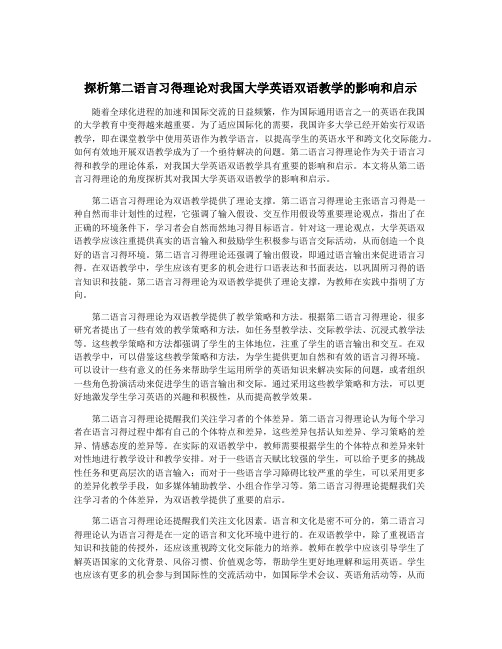
探析第二语言习得理论对我国大学英语双语教学的影响和启示随着全球化进程的加速和国际交流的日益频繁,作为国际通用语言之一的英语在我国的大学教育中变得越来越重要。
为了适应国际化的需要,我国许多大学已经开始实行双语教学,即在课堂教学中使用英语作为教学语言,以提高学生的英语水平和跨文化交际能力。
如何有效地开展双语教学成为了一个亟待解决的问题。
第二语言习得理论作为关于语言习得和教学的理论体系,对我国大学英语双语教学具有重要的影响和启示。
本文将从第二语言习得理论的角度探析其对我国大学英语双语教学的影响和启示。
第二语言习得理论为双语教学提供了理论支撑。
第二语言习得理论主张语言习得是一种自然而非计划性的过程,它强调了输入假设、交互作用假设等重要理论观点,指出了在正确的环境条件下,学习者会自然而然地习得目标语言。
针对这一理论观点,大学英语双语教学应该注重提供真实的语言输入和鼓励学生积极参与语言交际活动,从而创造一个良好的语言习得环境。
第二语言习得理论还强调了输出假设,即通过语言输出来促进语言习得。
在双语教学中,学生应该有更多的机会进行口语表达和书面表达,以巩固所习得的语言知识和技能。
第二语言习得理论为双语教学提供了理论支撑,为教师在实践中指明了方向。
第二语言习得理论为双语教学提供了教学策略和方法。
根据第二语言习得理论,很多研究者提出了一些有效的教学策略和方法,如任务型教学法、交际教学法、沉浸式教学法等。
这些教学策略和方法都强调了学生的主体地位,注重了学生的语言输出和交互。
在双语教学中,可以借鉴这些教学策略和方法,为学生提供更加自然和有效的语言习得环境。
可以设计一些有意义的任务来帮助学生运用所学的英语知识来解决实际的问题,或者组织一些角色扮演活动来促进学生的语言输出和交际。
通过采用这些教学策略和方法,可以更好地激发学生学习英语的兴趣和积极性,从而提高教学效果。
第二语言习得理论提醒我们关注学习者的个体差异。
第二语言习得理论认为每个学习者在语言习得过程中都有自己的个体特点和差异,这些差异包括认知差异、学习策略的差异、情感态度的差异等。
第二语言习得的作用及其对外语教学的启示
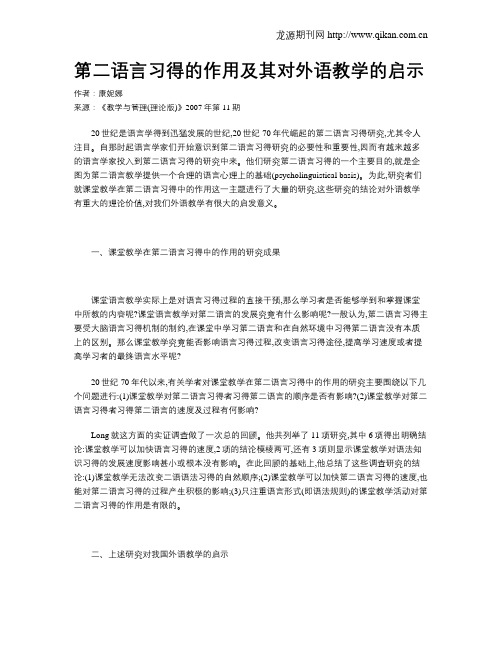
第二语言习得的作用及其对外语教学的启示作者:康妮娜来源:《教学与管理(理论版)》2007年第11期20世纪是语言学得到迅猛发展的世纪,20世纪70年代崛起的第二语言习得研究,尤其令人注目。自那时起语言学家们开始意识到第二语言习得研究的必要性和重要性,因而有越来越多的语言学家投入到第二语言习得的研究中来。他们研究第二语言习得的一个主要目的,就是企图为第二语言教学提供一个合理的语言心理上的基础(psycholinguistical basis)。为此,研究者们就课堂教学在第二语言习得中的作用这一主题进行了大量的研究,这些研究的结论对外语教学有重大的理论价值,对我们外语教学有很大的启发意义。一、课堂教学在第二语言习得中的作用的研究成果课堂语言教学实际上是对语言习得过程的直接干预,那么学习者是否能够学到和掌握课堂中所教的内容呢?课堂语言教学对第二语言的发展究竟有什么影响呢?一般认为,第二语言习得主要受大脑语言习得机制的制约,在课堂中学习第二语言和在自然环境中习得第二语言没有本质上的区别。那么课堂教学究竟能否影响语言习得过程,改变语言习得途径,提高学习速度或者提高学习者的最终语言水平呢?20世纪70年代以来,有关学者对课堂教学在第二语言习得中的作用的研究主要围绕以下几个问题进行:(1)课堂教学对第二语言习得者习得第二语言的顺序是否有影响?(2)课堂教学对第二语言习得者习得第二语言的速度及过程有何影响?Long就这方面的实证调查做了一次总的回顾。他共列举了11项研究,其中6项得出明确结论:课堂教学可以加快语言习得的速度,2项的结论模棱两可,还有3项则显示课堂教学对语法知识习得的发展速度影响甚小或根本没有影响。在此回顾的基础上,他总结了这些调查研究的结论:(1)课堂教学无法改变二语语法习得的自然顺序;(2)课堂教学可以加快第二语言习得的速度,也能对第二语言习得的过程产生积极的影响;(3)只注重语言形式(即语法规则)的课堂教学活动对第二语言习得的作用是有限的。二、上述研究对我国外语教学的启示1.循序渐进与因材施教上述研究的结论显示,我们的课堂教学是有用的,对学生的外语学习有积极的促进作用,而不是像有的人所认为的那样,课堂教学无助于学生的外语学习。上述结论促使我们反思现行的外语教学大纲是否合理。它提示我们,教学大纲中设计的语法规则的教授顺序应遵循学习者在第二语言环境中自然习得这些语法规则的顺序。只有这样,课堂教学才能促进学生的外语学习,才能达到教学目标。究其原因,Pienemann提出的“可学性假设”(learnability hypothesis)则对此作出了合理的解释:只有当学习者在语言心理上“准备就绪”(psycholinguistically ready)时,他们才能接受和掌握课堂上所学习的内容。这一点制约了课堂教学:只有当所教的语言结构接近学习者该阶段在自然环境中有能力习得的语言结构时,语言教学才能促进语言习得;超越学习者心理语言接受程度的课堂教学无法帮助他们掌握所教的内容和跨越语言发展的阶段,这就是“可教性假设”(teachability hypothesis)。“可教性假设”同时告诉我们,教师面对外语水平不同的学生应因材施教,不能“一视同仁”。若某一学生对前一语言阶段的语言结构还未习得,他是不大可能掌握后一阶段的语法的。对此,教师应善于判断学生所处的学习阶段,从而教授相应阶段的语法。2.语言输入与语言输出外语教学应把注意力放在学生语言形式的准确性上,还是放在语言的流利度上(the code communication dilemma),一直是外语教学领域的争论之一。关于这一争论,至今没有定论。然而,有关这一方面的研究大致上得出的结论是:只注重语言形式的外语教学对学生的第二语言习得所起的作用比以前人们所认为的小得多。这一点尤其要引起我国外语教学界的重视和反思。我国传统的外语教学就是将大部分的注意力放在学生的语言形式的准确性上。上课时教师主要讲授语法规则,认为学生只要知道语法规则就能自动地在课堂上及课后讲出正确流利的外语。其实不然,我国学生大多是在没有外语的语言环境中学习外语的,除了在课堂上有外语输入(input)外,课外几乎没有机会说外语。所以,外语教学课堂不仅讲授语法规则,而且应提供机会让学生讲外语,练习将所学的语法结构应用到实际的交流中。只有这样,通过大量的练习,学生才能将教师所教授的语言结构内化(internalize),也就是把所学的知识(learnt knowledge)变成习得知识(acquired knowledge),从而在用外语交流时能自动地应用这些语言结构。语言输出(output)的重要性得到了不少研究者(如Swain)的证实。他们认为,单纯的语言输入对语言习得是不够的,学习者应有机会使用语言,语言的输出对语言习得同样具有积极的意义。在习得的过程中,学习者对目标语不断地提出假设,并在使用语言中不断地对这些假设进行修正。如果学习者不能或者没有尝试着去使用语言,他们就很难有机会检验自己对目标语所作的各种假设。在语言输出的过程中,学习者往往能够得到他们所需要的各种反馈(如对方是否理解、是否反问等)。强调语言输出对语言习得具有积极意义并不是否认语言输入的重要性,而是更为客观地提出,语言输出是对语言输入的补充,他们都是语言习得的必要条件,而语言输入的内容应该是可理解的。这就是Krashen所提出的“可理解的语言输入”(comprehensible input,即含i+1的input),指学习者听到或读到的可以理解的语言材料,这些材料的难度应该稍高于学习者目前已经掌握的语言知识。例如,在讲完语法规则以后,教师可让学生听或看一个生动有趣的小故事,在这个故事的语言中包含了所讲授的语法知识。当然,有时候教材里的课文就是很好的易理解的输入材料。有关课堂教学在第二语言习得中的作用的调查研究还有待深入,这方面的研究成果必将进一步促进外语教学取得更好的成效。我国的外语教学有其自己的特点,但是上述理论研究同样对其有重要的指导意义和启发作用。我们应在本土特色的基础上,很好地将这些理论成果应用于实践,使我国的外语教学上一个新的台阶。参考文献[1] 刘润清.第二语言习得中课堂教学的作用.外语教学与研究,1993(1).[2] Long M.Does second language instruction make a difference?A review of research.TESOL Quarterly,1983,17(3).[3] Pienemann M.Learnability and syllabus construction.In K.Hyltenstam &M.Pienemann(eds)Modelling and Assessing Second LanguageDevelopment.Clevedon,Avon:Multilingual Matters ,1985.[4] Larsen F.,D.& Long M.H.An Introduction to Second Language Acquisition Research.Beijing: Foreign Language Teaching and Research Press,2000.[5] Swain municative competence:some roles of comprehensible input and comprehensible output in its development.In S.Class and C.Madden (eds.)Input in Second Language Acquisition,Rowley, MA:Newbury House,1985.[6] Krashen S.D.Principles and Practice in Second Language Acquisition.Oxford:Pergamon Press,1982.(责任编辑张茂林)。
第二语言习得

第二语言习得在当今全球化的社会中,学习第二语言已经成为越来越重要的技能。
随着跨国交流的增加,掌握一门外语不仅可以帮助个人更好地融入国际社会,还有助于扩大自己的人际关系和职业发展机会。
本文将探讨第二语言习得的重要性、影响因素以及有效的学习方法。
重要性第二语言的习得对个人的发展具有重要意义。
首先,学习第二语言可以帮助人们更好地理解和尊重不同文化,促进跨文化交流与合作。
其次,掌握第二语言可以扩大个人的视野,提高沟通能力,有助于解决跨文化交流中的误解和困难。
另外,学习第二语言还可以增强个人的认知能力,促进大脑的灵活性和思维方式的多样性。
影响因素第二语言习得受到多种因素的影响。
首先,个体因素是决定第二语言习得成效的重要因素之一,包括学习动机、学习策略、学习风格等。
同时,环境因素也对第二语言的习得起着至关重要的作用,如语言输入的频率和质量、社会支持和认可等。
此外,学习方法和教学资源也会影响第二语言的习得效果,因此选择合适的学习方式和资源对提高第二语言水平至关重要。
有效的学习方法要提高第二语言的习得效果,有一些有效的学习方法值得尝试。
首先,多听多说是提高口语能力的关键,可以通过模仿和实践来提高口语表达能力。
其次,阅读和写作也是提高语言能力不可或缺的部分,可以通过大量阅读和写作来扩大词汇量和提高语感。
另外,参加语言交流活动和与母语人士进行互动也是提高语言水平的有效途径,可以帮助加深对语言文化的理解和应用能力。
总之,第二语言的习得是一个长期的过程,需要不断地练习和实践。
只有通过持之以恒的努力和耐心,才能够真正掌握一门外语,提高综合语言能力,实现个人成长和发展的目标。
让我们共同努力,不断提升自己的第二语言水平,迎接更广阔的国际交流机遇。
第二语言习得理论在英语教学中的应用

第二语言习得理论在英语教学中的应用随着全球化和国际化的发展,英语作为全世界使用最广泛的语言之一,在中国的教育、经济、文化等各个领域都扮演着重要的角色。
因此,英语学习已成为现代化教育的重要内容之一。
然而,对于普通学生来说,学好英语并非易事。
在这个过程中,第二语言习得理论成为了英语教学师生们的重要研究对象。
第二语言习得理论,其目的是帮助人们更好地学习和掌握第二语言(L2)。
而对于英语教学而言,第二语言习得理论更是可以为英语教育者提供更好的指导方法和灵感。
基于这种理念,本文旨在探讨第二语言习得理论在英语教学中的应用。
第一部分:第二语言习得理论第二语言习得理论是指人们在学习第二语言时的内在心理过程。
研究发现,人们习得第二语言存在着与习得母语不同的心理机制和规律。
具体来说,第二语言习得理论主要包括以下几个方面:1、语言输入语言输入是指人们学习语言的过程中所接受到的信息。
语言输入对于第二语言习得的作用是至关重要的。
语言输入质量的高低会对第二语言习得产生积极或消极的影响。
与母语习得不同,第二语言习得需要有大量的相关语言输入。
同时,这种语言输入需要针对语言学习者的语言水平和语言需求等问题进行定制和设计。
2、暴露度和密度暴露度和密度是指第二语言习得者与第二语言接触的频率和持续时间。
如果学习者的暴露度和密度越高,那么其第二语言习得的速度和效果也就越高。
3、语言输出语言输出是指说话和写作等语言表达方式。
语言输出对于第二语言习得也有很大的作用。
通过自由的语言输出,第二语言习得者可以更好地巩固学习的知识和技能,并且可以更好地理解和应用学习过程中的错误。
4、语言规则和语言结构的学习语言规则和语言结构的学习是指学习者在习得第二语言的时候所需要掌握的基本语言规则和语言结构,包括句子结构、语法、单词运用等等。
这是学习者在语言习得过程中必须重点学习的内容。
第二部分:第二语言习得理论在英语教学中的应用1、提供优质的教育资源提供优质的教育资源是英语教学的重要组成部分。
第二语言习得理论研究概述讲解讲解学习
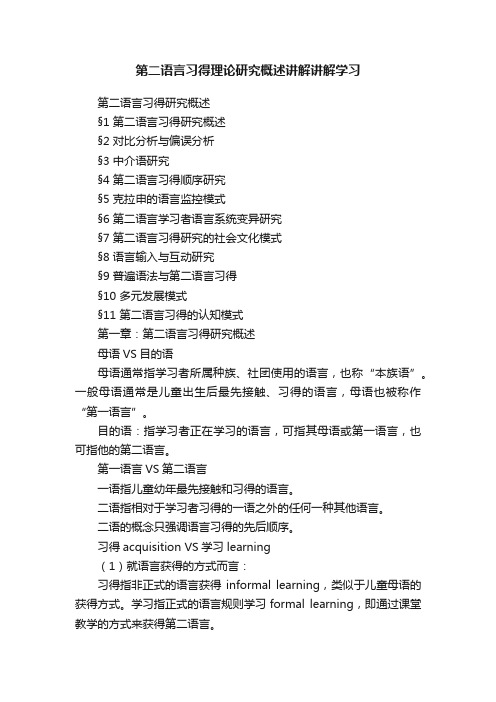
第二语言习得理论研究概述讲解讲解学习第二语言习得研究概述§1 第二语言习得研究概述§2 对比分析与偏误分析§3 中介语研究§4 第二语言习得顺序研究§5 克拉申的语言监控模式§6 第二语言学习者语言系统变异研究§7 第二语言习得研究的社会文化模式§8 语言输入与互动研究§9 普遍语法与第二语言习得§10 多元发展模式§11 第二语言习得的认知模式第一章:第二语言习得研究概述母语VS目的语母语通常指学习者所属种族、社团使用的语言,也称“本族语”。
一般母语通常是儿童出生后最先接触、习得的语言,母语也被称作“第一语言”。
目的语:指学习者正在学习的语言,可指其母语或第一语言,也可指他的第二语言。
第一语言VS第二语言一语指儿童幼年最先接触和习得的语言。
二语指相对于学习者习得的一语之外的任何一种其他语言。
二语的概念只强调语言习得的先后顺序。
习得acquisition VS学习learning(1)就语言获得的方式而言:习得指非正式的语言获得informal learning,类似于儿童母语的获得方式。
学习指正式的语言规则学习formal learning,即通过课堂教学的方式来获得第二语言。
(2)就语言获得的心理过程而言:习得指在自然状态下“下意识”的语言获subconscious learning。
学习指有意识的conscious语言知识的获得。
就语言获得的知识类型而言:通过习得方式获得的知识是隐性语言知识implicit knowledge,通过学习方式获得的知识是显性语言知识explicit knowledge。
★习得与学习的关系无接口观点non-interface position:认为通过习得和学习所获得的知识分别属于不同的且互相独立的类型,即隐性知识和显性知识。
有接口观点:认为显性知识通过操练可转化为隐性知识。
第二语言习得与学得的特征及作用论文

第二语言习得与学得的特征及作用论文第二语言习得与学得的特征及作用论文摘要:习得和学得在第二语言学习中的教育方式、学习场所、学习教材、学习意识等方面存在不同特征,运用上要注意把握好外因与内因、形式与内容、感性与理性认识、归纳与演绎的关系。
关键词:辩证;第二语言;习得;学得一、习得与学得的特征及作用的异同(一)相同特征习得和学得都是人作为主体在学习语言。
众所周知,人天生具有语言的本能,人的语言知识包括两个方面:一方面指的是全人类语言所共有的,称为普遍语法;另一方面指的是各民族语言所特有的,称为个别语法。
普遍语法是人类通过生物进化和遗传先天获得的。
所以,无论是自然中的外语习得者,还是课堂上的外语学习者都可以通过普遍语法获得母语以外的第二种语言,即语言获得机制都在起作用。
习得和学得都是对母语以外的第二语言的学习。
第二语言学习者都是掌握了第一语言系统的人,其认知系统已发展完善,已拥有一套成熟的解决问题的方法。
当面对学习任务时;他们便运用这套系统对语言进行分析、类比,形成假设和检验假设等有意识的思维活动。
根据母语的掌握来学习第二语言,并根据语言数据不断地对假设进行肯定、否定或修正。
(二)不同特征1.传授教育方面第二语言习得过程中,对小孩子来说,其最重要的老师是父母,其次是小朋友,再次是社会。
对于成人来说,就没有比较固定的老师了。
而在学校学得方面,在学校获得第二语言,从时间、教师、目标、测试等各个方面来看是非常规范的。
这是学校进行语言教学的一个显著特点。
在中国,从小学至大学,凡是语言教学,都有自己一整套的规范,保证了学校语言教学的规范性。
2.学习场所第二语言的自然习得没有固定的课堂,只要进行交际就是课堂。
不会因为时间和空间的限制而受到影响,相反,正是特定的时间和空间发生的交际活动,促进了第二语言习得者的言语经验知识积累。
也正是特定的时间和空间发生的交际活动,形成了第二语言习得者熟练的言语生成能力。
他们的语言能力是在大量以信息交流作为目的的真实交际活动中形成的。
(完整)《第二语言习得研究》重点知识点,推荐文档
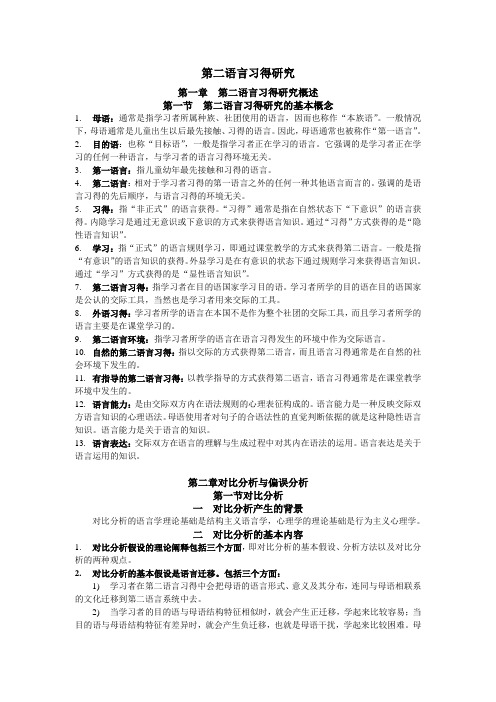
第二语言习得研究第一章第二语言习得研究概述第一节第二语言习得研究的基本概念1.母语:通常是指学习者所属种族、社团使用的语言,因而也称作“本族语”。
一般情况下,母语通常是儿童出生以后最先接触、习得的语言。
因此,母语通常也被称作“第一语言”。
2.目的语:也称“目标语”,一般是指学习者正在学习的语言。
它强调的是学习者正在学习的任何一种语言,与学习者的语言习得环境无关。
3.第一语言:指儿童幼年最先接触和习得的语言。
4.第二语言:相对于学习者习得的第一语言之外的任何一种其他语言而言的。
强调的是语言习得的先后顺序,与语言习得的环境无关。
5.习得:指“非正式”的语言获得。
“习得”通常是指在自然状态下“下意识”的语言获得。
内隐学习是通过无意识或下意识的方式来获得语言知识。
通过“习得”方式获得的是“隐性语言知识”。
6.学习:指“正式”的语言规则学习,即通过课堂教学的方式来获得第二语言。
一般是指“有意识”的语言知识的获得。
外显学习是在有意识的状态下通过规则学习来获得语言知识。
通过“学习”方式获得的是“显性语言知识”。
7.第二语言习得:指学习者在目的语国家学习目的语。
学习者所学的目的语在目的语国家是公认的交际工具,当然也是学习者用来交际的工具。
8.外语习得:学习者所学的语言在本国不是作为整个社团的交际工具,而且学习者所学的语言主要是在课堂学习的。
9.第二语言环境:指学习者所学的语言在语言习得发生的环境中作为交际语言。
10.自然的第二语言习得:指以交际的方式获得第二语言,而且语言习得通常是在自然的社会环境下发生的。
11.有指导的第二语言习得:以教学指导的方式获得第二语言,语言习得通常是在课堂教学环境中发生的。
12.语言能力:是由交际双方内在语法规则的心理表征构成的。
语言能力是一种反映交际双方语言知识的心理语法。
母语使用者对句子的合语法性的直觉判断依据的就是这种隐性语言知识。
语言能力是关于语言的知识。
13.语言表达:交际双方在语言的理解与生成过程中对其内在语法的运用。
探析第二语言习得理论对我国大学英语双语教学的影响和启示

探析第二语言习得理论对我国大学英语双语教学的影响和启示引言随着全球化趋势的加剧,英语已经成为国际交流和合作的重要语言。
在这个背景下,我国大学英语双语教学已成为教育改革的重要内容,如何提高大学生的英语水平成为了亟待解决的问题。
为此,我们需要深入探讨第二语言习得理论对我国大学英语双语教学的影响和启示。
一、第二语言习得理论概述第二语言习得理论是指人们学习第二语言的过程和方法的理论。
目前被广泛接受的第二语言习得理论主要有行为主义、认知心理学、社会交互学、认知语言学等多种理论。
在这些理论的指导下,人们对于第二语言习得的认识不断深化,也不断推动着相关教学方法和技术的发展。
二、对我国大学英语双语教学的影响1. 强调学习方法第二语言习得理论强调学习者的主动性和个体差异,这对我国大学英语双语教学提出了挑战。
传统的双语教学模式通常是由教师主导,学生被动接受。
而第二语言习得理论则提倡学生主动参与和学习,注重个性化的学习方法和策略。
大学英语双语教学需要从课堂教学模式转变为注重学生学习策略培养和个性化教学。
2. 注重语言输入第二语言习得理论强调学习者需要大量的语言输入来帮助他们进行语言习得。
这对于我国大学英语双语教学来说,就是要注重提供更多的真实语言环境和实际语言运用的机会。
这意味着在课堂教学中,需要增加学生的语言输入量,例如增加听力、口语训练和阅读活动等。
也需要创造更多的真实语境让学生进行实际的语言运用。
3. 重视社会交互社会交互学认为语言习得是通过社会交往和交流来实现的。
在大学英语双语教学中,也需要重视学生之间及学生与老师之间的交流和互动。
通过组织各种语言实践活动,如讨论会、辩论赛、角色扮演等,可以帮助学生更好地掌握英语语言并提高实际运用能力。
4. 强调认知过程认知语言学认为语言学习是通过认知过程来实现的。
在大学英语双语教学中,也需要注重学生的认知过程。
教师可以通过各种方式引导学生进行思维活动,启发学生的思维,帮助他们更好地理解和掌握英语语言知识。
第二语言习得研究中语言数据的分析方法及其对外语教学的启示

摘要语言学习是一种内在的过程自50 年代以来第二语言习得研究经过了对比研究这些不同的阶段体现了不同的理论基础每一种数据分析方法对第二语言习得研究均有其独特的贡献错误分析及语言使用分析这几种语言数据分析方法的阐述并从不同的语言分析方法中获得一些有关外语教学的启示语言数据分析方法AbstractGiven that learning is an internal process which cannot be observed directly, researchers make inferences as to the nature of the process in part from an analysis of the product, learner language. In order to improve the quality of these inferences, it is useful to examine the historical development of modes of data analysis, noting how different data analysis procedures evolved, with each successive type of analysis reflecting a new stage of awareness of what second language acquisition entails. And the understanding of the second language acquisition helps to improve language teaching.In second language acquisition research, there are different development stages, i.e. contrastive analysis, error analysis, performance analysisIntroductionSince second language acquisition is a new, uncharted field, it is by no means obvious how such investigation ought to be conducted. Many of its original research methodologies are consequently borrowed from first language acquisition research. Still others have come from education and the related disciplines. As their experience grows, however, second language acquisition researchers are becoming more creative in the way they seek answers to questions in their unique field of specialization. Nowadays, in second language acquisition research, there are various means that have been employed to collect SLA data. In this paper, we will trace the historical development of the types of data analysis in an attempt to come to a better understanding of the second language acquisition process. The discussion will be limited to the contrastive analysis, error analysis, performance analysis as well as their application and limitations. And some implications for foreign language teaching will be included in the discussion.Since contrastive analysis, error analysis and performance analysis are the ways to study learner performance, this paper will be carried out from this perspective. It begins with a discussion on contrastive analysis and its application and limitations. Then, Chapter Two gives an account of error analysis with its application and limitations. Chapter Three focuses on performance analysis with reference to some aspects of its study. By analyzing contrastive analysis, error analysis and performance analysis, we can be enlightened with regard to the implications adopted while teaching and learning a second language. To facilitate second language learning and teaching, teachers should adapt their teaching techniques and methods to meet learners’ requirements and help L2 learners to acquire the language effectively. Therefore, the last chapter comes up with the implications for foreign language teaching, which are based on the application and limitations of these modes of data analysis.Chapter OneContrastive AnalysisBefore the SLA field was established, researchers from the 1940s to the 1960s conducted contrastive analysis, systematically comparing two languages. They were motivated by the prospect of being able to identify points of similarity and difference between particular native languages and target languages, believing that a more effective pedagogy would result when these were taken into consideration.1.1 What Is Contrastive Analysis?Contrastive linguistics is defined as a subdiscipline of linguistics concerned with the comparison of two or more languages or subsystems of languages in order to determine both the differences and similarities between them. The contrastive analysis is concerned with not only the comparison and contrast of two or more languages to determine the differences as well as similarities between them, but also with the possible consequences for a given field of application. What’s more, it is also the identification of probable areas of difficulty in learning another language.As Lado (Ellis, 1999) makes clear, ‘The teacher who has made a comparison of the foreign language with the native language of the students will know better what the real problems are and can provide for teaching them.’ CA is developed in order to predict the areas of difficulty that learners with specific L1s would experience, so that teaching could provide massive practice to eliminate the chance of errors induced by the first language. This approach is based on the similarities and differences that exist between two or more languages, at the same time taking into account a number of axioms about L2 learning behaviour.1.2 The Contrastive Analysis HypothesisThe contrastive analysis hypothesis has its roots in behaviorism and structuralism. Behavioristic theories of human learning emphasize interfering elements of learning,claiming that interference means difficulty in learning. Structuralism lays a strong emphasis on differences between languages. Structural linguistics provides tools with which to describe accurately the two languages in question, and to match those two descriptions against each other to determine the differences and similarities between them.The conviction that linguistic differences can be used to predict learning difficulty gives rise to the contrastive analysis hypothesis---Where two languages are similar, positive transfer will occur; where they are different, negative transfer, or interference, will result.In general, the contrastive analysis hypothesis can be stated in three main versions, the strong version, the weak version, and the moderate version. The strong version is proposed by C. Fries and R. Lado. It emphasizes a priori prediction of difficulties in learning a second language. It states that all L2 errors can be predicted by identifying the differences between the target language and the learner’s L1. The weak version is proposed by Wardhaugh, which only recognizes the significance of interference across languages and tries to explain those difficulties. This version requires of the linguist only that he use the best linguistic knowledge available to him to account for observed difficulties in second language learning. It does not require the prediction of those difficulties, and conversely, of those learning points which do not create any difficulties. However, both versions agree that the greater the differences between the two languages, the greater the difficulties. That is, both versions equate differences between two languages with difficulties in L2 learning. The moderate version proposed by Oller and Ziahosseiny differs from the other two versions in that it emphasizes the significance of minimal distinctions, which may actually cause the greatest interferences and difficulties. According to them, the greatest difficulties in the second language are neither apparent similarities nor apparent differences, but subtle distinctions exist.However, from our teaching experience, we find that both great differences and subtle differences can cause difficulties. If we weaken the claim of predictability of the strong version, and integrate the three versions by paying attention to both greatand subtle differences between the two languages, we can make CA more useful to our teaching practice.1.3 Objectives of CAThe contrastive analysis is based on the following assumptions: A) Second language learning involves overcoming difficulties in the linguistic systems of the target language. B) The main difficulties in learning a second language are caused by interference from the first language. C) Contrastive analysis can predict, or at least account for, difficulties in L2 learning. D) Teaching materials based on contrastive analysis can reduce the effects of interference and difficulties and facilitate L2 learning. A number of fundamental and applied objectives have traditionally been attributed to CA. According to Van Els et al (1984), CA has the following three major objectives:1. Providing insights into similarities and differences between languagesThe first object can be interpreted as an attempt at establishing linguistic universals and language-specific characteristics of languages. Languages are not structurally isomorphic. Often there is divergence or convergence between L1 and L2. We speak of divergence for the L2 learner when there are more structural elements available in the target language for expressing specific meanings than can be found in the source language, while the opposite holds true in the case of convergence.As soon as any two languages have been described using the same theoretical categories, a work of reference can be provided for a systematic comparison and contrast of the major patterns in the two languages at the level or levels concerned. Comparison of a category in one language with a category in another language first of all presupposes a criterion of equivalence. To establish that the two systems are comparable, we first need to show their contextual equivalence, then ask to what extent they are formally equivalent.Let’s take the attributive possessive pronouns of English and their counterparts inChinese to illustrate this point. Their contextual equivalence can be shown by giving their principal contextual similarities and differences.First, both languages have the units “sentences”, “clause”, “phrase” and “word”. Secondly, both languages have a word class “noun” normally operating as the head of the nominal phrase and a word class “pronoun”, which may occur in the nominal phrase to replace the noun or the whole nominal phrase. Thirdly, the English attributive possessive pronoun and its counterpart in Chinese can only precede the noun it modifies. However, English attributive possessive pronouns have wider use than their counterparts in Chinese. English possessive pronouns, with the exception of the third person singular masculine and nonhuman, each has an attributive form as well as a predicative and nominal form. The predicative and nominal forms of possessive pronouns function independently as nouns rather than as determiners in prenominal positions. The possessive pronoun in Chinese has the same form whether it is used attributively or predicatively and nominally.PERSONENGLISH CHINESE PERSON ENGLISH CHINESE 1my 我的 3 masc his 他的 1+our 我们的 3 fem her 她的 你的 3 nonhum its 它的 2 您的 3+masc 他们的 2+your你们的 3+fem 她们的3+nonhum their 它们的From the table above, we can see that the first person attributive possessive pronouns, singular and plural, of the two languages have one-to-one correspondence. The major differences lie in the second and the third persons. First, in English the second person attributive possessive pronoun has only one form “your” for both singular and plural, whereas in Chinese the second person possessive pronoun has three forms: “你的” for singular familiar, “您的” for singular polite, and “你们的” forplural. Secondly, in English the third person plural attributive possessive pronoun has only one form “their” for masculine, feminine and nonhuman. But in Chinese, there are three different forms: “他们的” for masculine, “她们的” for feminine and “它们的” for nonhuman.As shown in the above example, the beginners may have difficulty in using the possessive pronouns in English and their counterparts in Chinese. The following sentences have the same meaning-- This is their book. /This book is theirs. /这是他们(她们)的书. In Chinese, the sentence only has one form, but in English it can be expressed with either attributive or nominal possessive pronouns. So it is probable for the beginners to confuse these two forms. Then based on the findings of the analysis, we can formulate a prediction of probable difficulties and errors in L2 learning, or account for existing difficulties and errors.2.Explanation and prediction of difficulties in second language learningAttempts have been made to formalize the prediction of difficulties. Prator (James, 1980) proposes a hierarchy of six levels of difficulty, which are applicable to grammatical features of language.Level 1—Transfer: When there is complete one-to-one correspondence between items or structures of the two languages in contrast, the learner can simply transfer positively these items or structures from the native language to the target language. These items or structures will cause no difficulties. For example, both French and English have the word ‘table’, which can have the same meaning in both languages.Level 2—Coalescence: When two or more items in the first language become coalesced into one in the target language, the leaner should overlook the distinction he has become used to when he uses the item in the second language. For instance, “他们/它们/她们” in Chinese equals to ‘they’ in English.Level 3—Underdifferentiation: When an item in the native language is absent in the target language, the learner must avoid that item when he uses the target language. To the English speakers, nouns may have singular and plural forms, while in Chinese the nouns only have singular form.Level 4—Reinterpretation: When an item that exists in the native language is given a new shape or distribution, the learner must learn that new shape or distribution. An example is French expertise (expert’s assessment) and English expertise (skillfulness).Level 5—Overdifferentiation: This is the opposite to level 3, that is, when a new item in the target languages bears little, if any, similarity to that in the native language, the leaner must learn it anew. ‘Do’ acts as an auxiliary verb in English, in Chinese there is no equivalent.Level 6—Split: This is the opposite to level 2, that is, when one item in the native language becomes two or more in the target language, the learner must learn to make a new distinction. To the English speaker learning French, ‘director’ becomes ‘directeur’ (masculine) and ‘directrice’ (feminine).3. Developing course materials for language teachingThis objective can be viewed as derived from the two objectives mentioned above, and is first stated in Fries (Van Els et al, 1984):‘The most effective materials for teaching a second language are those that are based upon a scientific description of the language to be learned, carefully compared with a parallel description of the native language of the learner.’And in the preface of Linguistics Across Cultures written by Lado, it is said:‘The plan of the book rests on the assumption that we can predict and describe the patterns that will cause difficulty in learning, and those that will not cause difficulty, by comparing systematically the language and culture to be learned with the native language and culture of the student. In our view, the preparation of up-to-date pedagogical and experimental materials must be based on this kind of comparison.’1.4 Application and Limitations of CA1. ApplicationContrastive analysis as applied to L2 teaching emphasizes differences betweenlanguages rather than similarities, and it is pedagogically-oriented, with the aim to discover and predict learning problems and difficulties. It has been used in the following areas: prediction, diagnosis of a proportion of the L2 errors committed by learners with a common L1, the design of testing instruments for such learners, course design and teaching.PredictionThere are four things that contrastive analysis can predict: First, what will cause problems; Second, difficulty in L2 learning; Third, errors that learners with the common L1 will make. The prediction of errors can mean either the prediction that there will be errors in certain areas or the prediction of the forms of errors. Contrastivists have more cautiously made predictions of the specific types of errors; and Fourth, the tenacity of certain errors, that is, the strong resistance of these errors to extinction through time and teaching.Diagnosis of ErrorsIt is important for both the teacher and the learner to know why certain errors are committed. Contrastive analysis can provide this kind of knowledge. It is on the basis of such diagnostic knowledge that the teacher can organize feedback to the learner and do some remedial work. Knowing why he has committed these errors provides the basis for the learner to monitor and avoid these same errors in the future.TestingOne of the requirements of a good language test is validity, that is, it should be a true measure of the student’s command of the language he has been learning. Test validity is usually achieved by testing a representative sample of the students’ repertoire. This is where contrastive analysis has a part to play. In general, contrastive analysis has three roles to play in testing. First, it can carry suggestions about what to test (such as the difficulties or the errors L2 learners will meet); Secondly, it can show to what degree to test different L2 items; Thirdly, it can suggest how to test these L2items. For objective tests, a contrastive analysis of L1 and L2 will suggest the type of distractors to use. The distractors may be the errors L2 learners with common L1 will make or the difficulties they will meet when learning L2. For integrative tests such as dictation and cloze, contrastive analysis may suggest which items are to be included in the dictation and which items are to be deleted in the cloze. That’s to say the phonologically similar items can be included in the dictation and the items having no close relation in morphology, lexics or grammar can be deleted in the cloze.Course Design and TeachingContrastive analysis can specify those features of L2 which are different from corresponding features of L1, and those which are identical. James (1980) suggests while the learner is exposed to all parts of the L2, he must be given opportunities to confirm his positive transfer on the one hand and to learn what he does not know on the other. Thus the importance of including both different and identical features in teaching materials is emphasized. Those L2 patterns not paralleled by equivalents in L1 will be introduced to the learner. Their presentation will be facilitated by the prior introduction of the identical variants taught at an earlier stage. Since it is a universal principle of education that learning should proceed from the simple to the difficult, it follows that items that are identical in L1 and L2 should be taught first. Contrastive analysis can show which items in the two languages are identical and which are different, and how identical and how different they are. Thus contrastive analysis can provide a basis for grading of teaching materials. Contrastive teaching involves presenting to the learner at the same time all the terms in a L2 system in contrast with the corresponding L1 system. The systems concerned may be grammatical, phonological, or lexical. These pairs of terms form problem-pairs. Such pairs should be suitably contextualized and analyzed. For these items in particular, we can use intensive techniques such as repetition or drills, in order to overcome the interference and establish the necessary new habits.2. LimitationsWhile the association of CAH with behaviorism gave it academic legitimacy, it ultimately led to its downfall. When predictions arising from CAs are finally subjected to empirical test, serious flaws are revealed. There are doubts concerning the ability of CA to predict errors. While CA predicts some errors, it clearly does not anticipate all. If a majority of learner errors are not caused by interference, then CA is of limited value, far less than is thought to be the case when CA first started. For instance, the way an error is classified, e.g. due to L1 interference or not, differs from study to study. Whiteman and Jackson (1972), who tested the predictions of four different CAs of English and Japanese by studying the English performance of 2500 Japanese secondary school students on a multiple choice and a cloze test, conclude that contrastive analysis is inadequate to predict the interference problems of a language learner. The interference plays such a small role in language learning performance that no contrastive analysis, no matter how well it is conceived, can correlate highly with performance data, at least at the level of syntax. Thus, a comparison of the learner’s L1 and L2 can’t help to predict or explain very much about the process of SLA.Although CA is as old as FLT itself, attempts at converting descriptive data from CA into teaching programs have by no means always been successful. Neither has there been systematic research into the effect of teaching methods based on CA; it has never been demonstrated that course materials based on CA are more effective than other materials based on different principles. The realization that linguistic difference can not be equated with learning problem has made people reticent to implement the objectives of CA.In a word, CA ascribes most errors to interference of L1, but empirical evidence has shown that interlingual errors (i.e. errors caused by the interference of the learner’s L1) only constitute a small proportion of L2 learners’ errors, and that among other factors, intralingual effects of learning (i.e. result from the structure of the L2 itself) play an important role. CA which aims to predict errors resulting from L1 interference fails to account for other types of errors. Linguistic differences betweenL1 and L2 do not automatically lead to L2 learning problems, and not all L2 learning problems can be retraced to linguistic differences between L1 and L2. As the interference was replaced by other explanations of learning difficulties in 1970s, CA declined. But as a methodological option, it isn’t abandoned. As such, it is useful in a broader approach to detecting the source of error, namely error analysis.Chapter TwoError AnalysisAt the end of 1960s, people began to question one of the main objectives of contrastive analysis, namely the explanation and prediction of L2 learning problems. People began to realize more and more that this approach left the L2 learner out of consideration. The fact that there was no empirical basis for CA in turn resulted in more attention being paid to error analysis. This notion became popular in L2 learning research after 1970.2.1 What Is Error Analysis?Error analysis is an activity which is at once ancient and new. It is ancient in that since ancient times this technique has been used by teachers, but in an informal and intuitive way. It is new because as a scientific technique based on psycholinguistics it was developed in the late sixties. Along with the birth of psycholinguistics, the focus in second language teaching shifts from the view of the teacher as the controller of language learning towards a more learner-centered view which stresses learners’ creative role in L2 learning. One major result of this shift has been the development and application of error analysis as a chief means of both assessing learners’ learning in general and of the degree of match between their learning syllabus and the teacher’s teaching one.According to Longman Dictionary of Applied Linguistics, error analysis is the study and analysis of the errors made by second and foreign language learners. It is a methodology of describing L2 learners’ language systems. EA aims to find out how well the learner knows and learns a language, and it obtains information on common difficulties in language learning as an aid in teaching or in the preparation of teaching materials. It also provides data from which inferences about the nature of the second language learning process can be made.Error analysis is distinguished from contrastive analysis by its examination of errors attributable to all possible sources, not just those which result from theinterference of the first language. Therefore, although error analysis and contrastive analysis are not mutually exclusive, the former can easily supersede the latter.2.2 Fundamentals and Significance of EACorder (1981) claims that learners’ errors provide to the researcher evidence of how the target language is learned or acquired and what strategies or procedures the learner is employing in his discovery of the language.Human learning is fundamentally a process involving making errors, which forms an important aspect of learning any skill or acquiring any knowledge. Language learning is like any other human learning. In the course of learning a second language, learners will produce utterances which are ungrammatical or otherwise ill-formed, when judged by generally accepted rules of the language they are learning. This is obvious not only to teachers of languages but to any native speaker of the target language who comes in contact with them. That is to say L2 learning, like L1 acquisition, is trial and error in nature, hence errors are unavoidable. Errors made by L2 learners can be observed, analyzed, classified, and described. In errors made by L2 learners lie some of the keys to the understanding of the process of second language learning.A learner’s errors, then, provide evidence of the system of the language that he is using at a particular point in the course. Second language learners can be viewed as actively constructing rules from the data they encounter and gradually adapting these rules in the direction of the target language system. Then the speech of second language learners can be analyzed in its own terms. Learners’ errors are the clearest evidence for the learner’s developing systems and can offer us insights into how they process the data of the language. If learners actively construct a system for the second language, we will not expect all their incorrect notions about it to be a simple result of transferring rules from their first language. We will expect many of their incorrect notions to be explicable by direct reference to the target language itself. This is, in fact precisely what error analysis reveals. In addition to errors due to transferring rulesfrom the mother tongue, learners also make many errors which show that they are processing the second language in its own terms. Errors of this type are often similar to those produced by the child in the mother tongue and suggest that the second language learner is employing similar strategies, notably generalization and simplification. From these errors, which represent the product of learning, we can also gather hints about the underlying process of learning.2.3 Description and Explanation of ErrorsAccording to the stages in which errors are made, Corder (James, 1998) identifies three stages: The first is the presystematic stage. In this stage the learner is only vaguely aware that the target language has a particular system, but his use of the target language is through random guessing. He is neither able to correct his errors nor to explain them. The second is the systematic stage. In this stage the learner has discovered some rules of the system of the target language, but is inconsistent in applying these rules. He usually cannot correct his errors although he can explain why he makes them. The third is the postsystematic stage. In this stage the learner is quite consistent in his use of the target language. When he makes an error, he can both correct it and explain why it is incorrect. Though errors still exist in this stage, the occurrence of errors becomes infrequent.Errors of CompetenceTo be sure, L2 learners still commit errors which can be traced to L1 interference and as such are termed interlingual errors. They are caused by the structure of L1. A large number of similar errors are being committed by second language learners, regardless of their L1.These errors are called intralingual errors. They are caused by the structure of L2. Interlingual errors depend on linguistic differences between L1 and L2 and are traditionally interpreted as interference problems. Intralingual errors are by definition not predictable on the basis of CA, they can not be traced back to differences between L1 and L2, but they relate to a specific interpretation of the target。
第二语言习得概
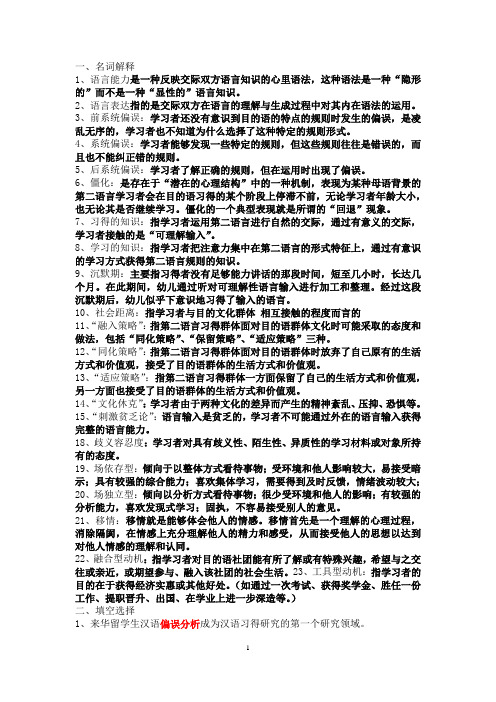
一、名词解释1、语言能力是一种反映交际双方语言知识的心里语法,这种语法是一种“隐形的”而不是一种“显性的”语言知识。
2、语言表达指的是交际双方在语言的理解与生成过程中对其内在语法的运用。
3、前系统偏误:学习者还没有意识到目的语的特点的规则时发生的偏误,是凌乱无序的,学习者也不知道为什么选择了这种特定的规则形式。
4、系统偏误:学习者能够发现一些特定的规则,但这些规则往往是错误的,而且也不能纠正错的规则。
5、后系统偏误:学习者了解正确的规则,但在运用时出现了偏误。
6、僵化:是存在于“潜在的心理结构”中的一种机制,表现为某种母语背景的第二语言学习者会在目的语习得的某个阶段上停滞不前,无论学习者年龄大小,也无论其是否继续学习。
僵化的一个典型表现就是所谓的“回退”现象。
7、习得的知识:指学习者运用第二语言进行自然的交际,通过有意义的交际,学习者接触的是“可理解输入”。
8、学习的知识:指学习者把注意力集中在第二语言的形式特征上,通过有意识的学习方式获得第二语言规则的知识。
9、沉默期:主要指习得者没有足够能力讲话的那段时间,短至几小时,长达几个月。
在此期间,幼儿通过听对可理解性语言输入进行加工和整理。
经过这段沉默期后,幼儿似乎下意识地习得了输入的语言。
10、社会距离:指学习者与目的文化群体相互接触的程度而言的11、“融入策略”:指第二语言习得群体面对目的语群体文化时可能采取的态度和做法,包括“同化策略”、“保留策略”、“适应策略”三种。
12、“同化策略”:指第二语言习得群体面对目的语群体时放弃了自己原有的生活方式和价值观,接受了目的语群体的生活方式和价值观。
13、“适应策略”:指第二语言习得群体一方面保留了自己的生活方式和价值观,另一方面也接受了目的语群体的生活方式和价值观。
14、“文化休克”:学习者由于两种文化的差异而产生的精神紊乱、压抑、恐惧等。
15、“刺激贫乏论”:语言输入是贫乏的,学习者不可能通过外在的语言输入获得完整的语言能力。
- 1、下载文档前请自行甄别文档内容的完整性,平台不提供额外的编辑、内容补充、找答案等附加服务。
- 2、"仅部分预览"的文档,不可在线预览部分如存在完整性等问题,可反馈申请退款(可完整预览的文档不适用该条件!)。
- 3、如文档侵犯您的权益,请联系客服反馈,我们会尽快为您处理(人工客服工作时间:9:00-18:30)。
言加 工过 程 的唯一语 料来 源 ;2 语 言输人 必 须被理 () 解 才能转 变成 吸收 而被加 工 ;3 语 义推 敲和会 话互 () 动 可 以协 助工作 记忆 更有 效地 进行 输人 处理 。由以 上 的分 析可 以进一 步 得 出 , 话互 动 和 语 义 推 敲对 会 于 通过交 际学 习第 二 语 言非 常有 帮 助 , 其 效 率 和 是 效果 的重要决 定 因素 。
Fe . O 2 b 2 1
F 的 第 二 语 言 习得 价 值 分析 T
董 攀
( 南 民族 大 学 外 语 学 院 , 北 武 汉 中 湖 4 O7 ) 3 O 4
摘 要 : 言 输 入 只 有 被 理解 才能 被 转 化 为 语 言 体 系 发 展 所 需 的 语 言 吸 纳 资 源 。语 言 研 究 者 发 现 外 国 人 和 外 语 学 习 者 交 流 时 使 语 用的F T具 有 语 义 调 整 和 互 动 调 整 的 特 点 。这 种 特 点 使 得 语 言 输 入 能 够 在交 流 中更 好 地 促 进 且 丰 富 可理 解 的语 言 吸 纳 的 形 成 , 从 而推 动外 语 学 习 者 新 语 言 体 系 的 有效 发 展 。
言 输 入 不 能 直 接 转 化 为 发 展 语 言 体 系 的 材 料 , 须 必 通 过 转 化 为 学 习 者 可 理 解 的 语 言 吸 纳 ( tk ) 在 i ae 。 n
者 意 味 着 有 更 多 的 与 外 国 人 直 接 进 行 外 语 交 流 的 机 会 , 就 是 说 学 习 者 可 以 获 得 大 量 的 F F rin r 也 T( oeg e
脑 的一 种功 能 , 主 要 的语 言 学 习作 用 就是 适 时 将 其
语 言 输 入 转 化 为 可 理 解 和 进 一 步 加 工 的 语 料 。但 从 生 理 学 和 认 知 心 理 学 的 角 度 讲 , 作 记 忆 的 容 纳 能 工 力 是有 限 的 , 而 , 入 的质 量在 很大 程度 上决定 了 因 输
由以上分 析得 出 :1语言输 入 是进入 学 习者语 ()
( ) 言 输 入 和 语 言 习 得 一 语 语 言 输 入 对 于 语 言 习 得 的 作 用 再 怎 样 强 调 也 不
为过 。可 以这么说 , 有语 言输入 , 言习得 就不 可 没 语 能 发生 。Va p t n也 曾将 语 言 输入 在语 言 习得 中 n at e 作 用 的发现 与天 文学 发现地 球绕 太 阳转 以及 生物 学 关 于物 种 的演变 的基本 发现 相提并 论u 。这 说 明语 言输入 在语 言 习得 中的重要 性 。在第 二语 言习得 领 域 , 言 输 入 是 指 学 习 者 听 到 或 读 到 的 那 些 具 有 某 语
关键 词 : 语 习 得 ; 言输 入 ;F 语 义 推 敲 二 语 T; 中 图分 类 号 : l H3 3 文献 标 识 码 : A 文 章 编 号 : 6 2 3 9 2 1 ) 2 0 6— 2 1 7 —5 7 ( 0 2 0 —0 9 0
ቤተ መጻሕፍቲ ባይዱ
全球 化 的不 断深 入和 发展 对于 我 国的外语 学 习
一
工作记 忆 的效率 。所谓 语 言输入 的质 量主 要是指 输
入 的可 理 解 和 丰 富 程 度 。 只 有 可 理 解 的 语 言 输 入 才
能提 高工作 记忆 的工作 效 果 , 而 促 进 语 言体 系 的 从 良好建 立 和发展 。而会 话互 动 的作用 在于 促进语 言 的可 理解性 和 增 加 更 为 丰 富 的语 言 输 入 。在 Va — n p t n后续 的语 言 输 入 到输 出 的修 改 描 述 模 型 中 , at e
T l) ak 。大多 数第 二语 言 习 得 的研 究 者 普 遍认 为丰 富的 F T是学 好 外 语 的 关键 , 一 点 可从 很 多在 国 这 外学 习外 语 的成功 学 习者 身上 得到 证实 。决定 第二 语 言学 习效果 的 因素 很 多 , 从 这些 成 功 者 的 例子 但 中很 容 易 看 到一 个 共 同 的作 用 因 素 , 即大 量 的 F T 语 言输入 。笔 者 将 从 第 二 语 言 学 习 的 过 程 模 型 和 F 的语 言 、 际特 点 两 方 面 分 析 , 出 F 外语 学 T 交 找 T 习高价值 的根 源 。
有 引起 学 习者注 意并 对其作 出相 应反 应 的信 息 。
( ) 二 语 言 习 得 模 型 二 第 第 二 语 言 习得 过 程 主要 是 由三个 步 骤组 成 的 :
二 、 T 特 点 的 研 究 概 述 F
【 ) T 的 语 言 调 整 特 点 一 F
语 言输 入 (n u) 语 言 系统 的发展 ( a g a eS s Ip t 、 L n u g y— tm De e p n ) e v l me t和语 言输 出( t u ) o Oup t 。其 中 ,语
他 在 此 加 入 了 两 个 概 念 : 义 推 敲 ( g t t n 和 语 Ne oi i ) ao
会话互 动 (neat n , 两 个 概 念 用 来 代 表 语 言 Itrci ) 这 o
、
第 二 语 言 习得 模 式
交流 中 的两种方 式 , 要 作 用 在 于通 过 促 进 可理 解 主 语言 输入 的产生 从 而帮助 工作记 忆更 好地 进行 语言 输入 到语 言吸 收 的转 化u 。
第 l O卷第 2期 2 2年 2月 01
西南农业大学学报( 会科学版) 社
J u n l fSo t wetAg iut r lUnv riy S ca ce c iin o r a u h s rc lu a ie st ( o ilS in eEdto ) o
V o . O。 1 1 NO. 2
